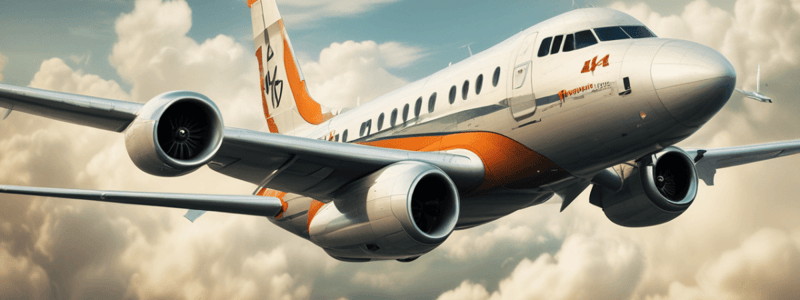Podcast
Questions and Answers
What is the role of the International Civil Aviation Organisation (ICAO)?
What is the role of the International Civil Aviation Organisation (ICAO)?
Setting international standards in aviation
How are ICAO standards incorporated into Australian law?
How are ICAO standards incorporated into Australian law?
- Through adoption by CASA
- Through direct implementation in local regulations (correct)
- Through parliamentary approval
- Through international treaties
What are the basic knowledge levels indicated by the allocation of knowledge levels indicators for categories A, B1, and B2?
What are the basic knowledge levels indicated by the allocation of knowledge levels indicators for categories A, B1, and B2?
1, 2, 3
What is the official name for the Convention on International Civil Aviation?
What is the official name for the Convention on International Civil Aviation?
When was the International Civil Aviation Organization (ICAO) established?
When was the International Civil Aviation Organization (ICAO) established?
What is the main objective of LEVEL 2 knowledge in aircraft maintenance licensing?
What is the main objective of LEVEL 2 knowledge in aircraft maintenance licensing?
What is the main objective of LEVEL 3 knowledge in aircraft maintenance licensing?
What is the main objective of LEVEL 3 knowledge in aircraft maintenance licensing?
Australia is a Contracting State to ICAO.
Australia is a Contracting State to ICAO.
CASA was established as an independent statutory authority under the __________.
CASA was established as an independent statutory authority under the __________.
What are Civil Aviation Orders known as?
What are Civil Aviation Orders known as?
CAAPs are legally binding regulatory orders.
CAAPs are legally binding regulatory orders.
What is the purpose of Part 147 of the CASR?
What is the purpose of Part 147 of the CASR?
______ are advisory documents providing recommendations and guidance for complying with regulations.
______ are advisory documents providing recommendations and guidance for complying with regulations.
What is one objective of the CASR 1998?
What is one objective of the CASR 1998?
Which international regulations are mentioned in the context of Australia's aviation safety laws?
Which international regulations are mentioned in the context of Australia's aviation safety laws?
The FARs are the Federal Aviation Regulations, part of the Code of Federal Regulations of the United States of America. In the context of the United States, the FARs are the exact equivalent of __________ regulations.
The FARs are the Federal Aviation Regulations, part of the Code of Federal Regulations of the United States of America. In the context of the United States, the FARs are the exact equivalent of __________ regulations.
EASA replaces an EU member state's National Aviation Administration.
EASA replaces an EU member state's National Aviation Administration.
What is a type-rated aircraft licence?
What is a type-rated aircraft licence?
What defines a large aircraft (rotary-wing)?
What defines a large aircraft (rotary-wing)?
Standard category aircraft operate under a Standard Certificate of Airworthiness (CofA).
Standard category aircraft operate under a Standard Certificate of Airworthiness (CofA).
The Part 66 MOS specifies the requirements for the issue of an aircraft engineer licence in ______ategory A, ______ategory B1, ______ategory B2, and ______ategory _.
The Part 66 MOS specifies the requirements for the issue of an aircraft engineer licence in ______ategory A, ______ategory B1, ______ategory B2, and ______ategory _.
Match the following: Category A and B1 endorsements
Match the following: Category A and B1 endorsements
What type of aircraft are not listed in Appendix IX of the Part 66 MOS?
What type of aircraft are not listed in Appendix IX of the Part 66 MOS?
According to the Guidance Material to MOS 66.A.20, Table 1 designates aircraft systems as mechanical, powerplant, structural, electrical, or avionic. In certain cases, when aircraft systems intersect, who may provide maintenance certification?
According to the Guidance Material to MOS 66.A.20, Table 1 designates aircraft systems as mechanical, powerplant, structural, electrical, or avionic. In certain cases, when aircraft systems intersect, who may provide maintenance certification?
Type-rated aircraft maintenance can be carried out by Category B2 licence holders.
Type-rated aircraft maintenance can be carried out by Category B2 licence holders.
A person who holds a Category C licence may issue a CRS for base maintenance carried out on a ______ aircraft.
A person who holds a Category C licence may issue a CRS for base maintenance carried out on a ______ aircraft.
Flashcards are hidden until you start studying
Study Notes
Category B Licence
- Category B Licence is part of CASA B-10c, which covers Aviation Legislation
Knowledge Levels
- Basic knowledge levels are indicated by allocation of knowledge levels indicators (1, 2 or 3) against each applicable subject
- Knowledge levels apply to Category A, B1, B2 and C Aircraft Maintenance Licence
Level 1
- Familiarity with basic elements of the subject
- Ability to give a simple description of the whole subject using common words and examples
- Ability to use typical terms
Level 2
- General knowledge of theoretical and practical aspects of the subject
- Ability to apply that knowledge
- Ability to understand theoretical fundamentals of the subject
- Ability to give a general description of the subject using typical examples
- Ability to use mathematical formulae in conjunction with physical laws
- Ability to read and understand sketches, drawings and schematics
- Ability to apply knowledge in a practical manner using detailed procedures
Level 3
- Detailed knowledge of theoretical and practical aspects of the subject
- Capacity to combine and apply separate elements of knowledge in a logical and comprehensive manner
- Ability to know the theory of the subject and interrelationships with other subjects
- Ability to give a detailed description of the subject using theoretical fundamentals and specific examples
- Ability to use mathematical formulae related to the subject
- Ability to read, understand and prepare sketches, simple drawings and schematics
- Ability to apply knowledge in a practical manner using manufacturer's instructions
- Ability to interpret results from various sources and measurements and apply corrective action where appropriate### Regulatory Framework (10.1)
- The International Civil Aviation Organization (ICAO) is responsible for setting international standards and recommended practices for civil aviation.
- ICAO standards are incorporated into Australian law through the Civil Aviation Act 1988 and the Civil Aviation Regulations 1998 (CASR).
Part 66 Certifying Staff I (10.2)
- Key terms:
- Type Ratings: a certification that allows an aircraft engineer to work on a specific type of aircraft.
- Category A Licence: a certification that allows an aircraft engineer to work on simple aircraft systems.
- Category B1 Licence: a certification that allows an aircraft engineer to work on complex aircraft systems.
- Category B2 Licence: a certification that allows an aircraft engineer to work on avionics systems.
- Aircraft types:
- Large aircraft: defined as an aircraft with a maximum take-off weight (MTOW) of 5700 kg or more.
- Small aircraft: defined as an aircraft with an MTOW of less than 5700 kg.
- Primary Category Aircraft: defined as aircraft with a MTOW of 750 kg or less.
- Standard Category Aircraft: defined as aircraft with a MTOW of more than 750 kg.
- Part 66 Manual of Standards (MOS):
- Provides guidance on the certification of aircraft engineers.
- Outlines the requirements for obtaining a Part 66 licence.
- Covers the requirements for certification, privileges, and limitations.
Approved Maintenance Organisations I (10.3)
- CASR Part 145: sets out the regulations for approved maintenance organisations (AMOs).
- An AMO is an organisation that has been approved by CASA to perform maintenance on aircraft and aeronautical products.
- AMOs must have a safety management system (SMS) in place.
- AMOs must have an exposition, which is a document that outlines the organisation's policies and procedures.
- AMO requirements:
- Maintenance facility requirements: must have suitable facilities and equipment to perform maintenance.
- Office accommodation: must have suitable office space and equipment.
- Storage facilities: must have suitable storage facilities for parts and materials.
- Personnel requirements: must have suitably qualified and experienced personnel.
Air Operations (10.4)
- Air Operator's Certificates (AOCs):
- An AOC is a certification that allows an airline to operate aircraft.
- AOCs are issued by CASA and are subject to certain conditions.
- Air Operator's Certificates Requirements:
- An airline must have an AOC to operate aircraft in Australia.
- An AOC is issued for a specific period of time and must be renewed.
- The airline must comply with the conditions of the AOC.
Certification of Aircraft, Parts and Appliances I (10.5)
- Part 21: sets out the regulations for the certification of aircraft, parts, and appliances.
- Certification of aircraft: involves the issuance of a type certificate, which is a certification that the aircraft meets the required safety standards.
- Certification of parts and appliances: involves the issuance of a production certificate, which is a certification that the part or appliance meets the required safety standards.
- Aeronautical Product Classification:
- Class I products: are critical to the safety of the aircraft and passengers.
- Class II products: are important to the safety of the aircraft and passengers but are not critical.
- Class III products: are not critical to the safety of the aircraft and passengers.
Parts 21 and 42 of CASR 1998 (10.6)
- Part 21 of CASR 1998:
- Sets out the regulations for the certification of aircraft, parts, and appliances.
- Covers the requirements for type certification, production certification, and airworthiness certification.
- Part 42 of CASR 1998:
- Sets out the regulations for the continuing airworthiness of aircraft and aeronautical products.
- Covers the requirements for the maintenance of aircraft and aeronautical products.
Applicable National and International Requirements in Maintenance I (10.7)
- Regulations and guidelines:
- CASR: sets out the regulations for the maintenance of aircraft and aeronautical products.
- Manufacturer's maintenance schedules: provide guidance on the maintenance requirements for specific aircraft and aeronautical products.
- Approved maintenance programs:
- An approved maintenance program is a program that has been approved by CASA.
- The program must be in place and must be followed by the maintenance organisation.
Applicable National and International Requirements in Maintenance II (10.7)
- Continuing airworthiness requirements:
- All aircraft must be certified as airworthy before they can be operated.
- The continuing airworthiness of the aircraft must be maintained through regular maintenance and inspections.
- Defect reporting:
- Defects must be reported to CASA.
- The defect report must include information about the defect and the corrective action taken.
Note: These notes are a condensed version of the original text and are intended to provide a brief overview of the key concepts and regulations.### International Civil Aviation Organization (ICAO)
- Established in 1947, with 52 states signing the Convention on International Civil Aviation (Chicago Convention) in 1944
- ICAO's purpose is to secure international co-operation and uniformity in regulations and standards
- Adopt and amend international standards and recommended practices and procedures for safety, regularity, and efficiency of air navigation
- Provides a means to secure international co-operation and uniformity in regulations and standards
- Headquartered in Montreal, Canada
ICAO Structure
- Comprises of an Assembly, a Council, and a Secretariat
- The Assembly is the sovereign body, comprising representatives from all contracting states
- The Council is the governing body, giving continuing direction to the work of ICAO
- Non-governmental organisations participate in ICAO's work, including the International Air Transport Association and the International Federation of Air Line Pilots' Associations
Australia's Civil Aviation Regulations
- The Civil Aviation Act 1988 is the body of law that links Australia with the international aviation community
- The Civil Aviation Act 1988 is implemented in Australia by the Civil Aviation Safety Regulations 1998
- The Civil Aviation Regulations (CAR) 1988 and the Civil Aviation Safety Regulations (CASR) 1998 provide general regulatory controls for the safety of air navigation
Civil Aviation Safety Authority (CASA)
- Established in 1995 as an independent statutory authority
- Conducts the safety regulation of civil air operations in Australia and the operation of Australian aircraft overseas
- Provides comprehensive safety education and training programs
- Cooperates with the Australian Transport Safety Bureau and administers certain features of Part IVA of the Civil Aviation (Carriers' Liability) Act 1959
Legislative Documents
- The Civil Aviation Act 1988 and the CAR 1988 empower CASA to issue Civil Aviation Orders (CAOs) on detailed matters of regulation
- The CASRs 1998 empower CASA to issue Manuals of Standards (MOS) that support the CASR by providing detailed technical material
- Civil Aviation Advisory Publications (CAAPs) provide guidance and information in a designated subject area
- Advisory Circulars (ACs) provide recommendations and guidance to illustrate a method, or several methods, not necessarily being the only method by which legislative requirements may be met
CASR 1998
- The Regulations contain many regulations within them
- The Civil Aviation Act 1988, the CASR 1998, and the CAR 1988 give effect to some of Australia's obligations under the Convention on International Civil Aviation
Maintenance Regulations
- In general, these regulations are based on organisational approvals, with less reliance on individual approvals and delegations
- Focus on organisation systems, with CASA managing compliance by permission, application assessments, and ongoing oversight
Part 21
- Affects anyone in the Australian aviation community involved in the design, manufacture, and airworthiness certification of aircraft, aeronautical products, and parts
- Sets out the requirements for approval as an approved design organisation, as well as for the associated privileges and obligations
- Includes rules relating to Type Certificates, Type Acceptance Certificates, Supplemental Type Certificates, Production Certificates, Certificates of Airworthiness, and export airworthiness approvals
Parts 42 and 145
- CASR Parts 42 and 145 only apply to Regular Public Transport operators operating under an Air Operator's Certificate (AOC)
- A maintenance provider for a Regular Public Transport operator must be a Part 145 Approved Maintenance Organisation (AMO) under the CASR
Studying That Suits You
Use AI to generate personalized quizzes and flashcards to suit your learning preferences.




